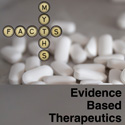Episode 113: How to interact with drug interactions
In episode 113, Mike and James interact in a mainly positive way about what to do with the 1000s of drug interactions that are out there. They talk about the concepts of pharmacokinetic and pharmacodynamic interactions and outline which ones appear to be clinically important. At the end they realise that all of their interactions over the last 113 podcasts episodes have been clinically irrelevant and vow to interact much more usefully in the future.
Show notes
1) Hospitalizations due to interactions
2) Plasma-protein binding interactions – they are not clinically important
Br J Clin Pharmacol 1994;37:125-8
3) Key Players in Metabolism Drug Interactions
Inhibitors
fluvoxamine
gemfibrozil
fluconazole
omeprazole
paroxetine
fluoxetine
clarithromycin
Inducers
Rifampin
carbamazepine
4) What drug interactions are clinically important?
J Am Pharm Assoc 2004;44:142–151
THE MAIN ONES (DRUG affected – DRUG interacting)
Warfarin – Thyroid, NSAIDs, cimetidine, fibric acid, barbiturates, sulfinpyrazone
Benzodiazepines – Azoles
Carbamazepine – Propoxyphene, macrolides
Cyclosporine – Rifampin
Dextromethorphan – MAOIs
Digoxin – Clarithromycin
Ergots – Macrolides
Ganciclovir – Zidovudine
MAOIs – Sympathomimetics
Meperidine – MAOIs
Methotrexate – Trimethoprim
Nitrates – Sildenafil
Pimozide – Macrolides, azoles
SSRIs – MAOIs
Theophylline – Quinolones, fluvoxamine
5) Oral contraceptives and antibiotic interactions – a myth?
J Am Acad Dermatol 2002;46:917-23
6) Drug interaction websites/tools
http://www.drugs.com/drug_interactions.php
http://www.rxfiles.ca/rxfiles/uploads/documents/members/cht-herbal-di.pdf
iPhone apps – Medscape, Epocrates
Listening to this episode is for premium podcast members only. If you already have a membership, login to your account. If you aren't yet a premium subscriber, sign up today!


